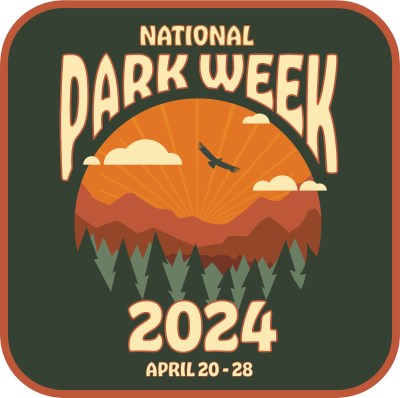Love national parks? There's a holiday for that! Join us for National Park Week, a nine-day celebration of everything "parks". Not just about more than 400 national parks nationwide of different shapes, sizes, and types. Also discover what the National Park Service does through our programs and partners to preserve natural and cultural heritage and provide recreational opportunities in places across the country—and even the world!
National Park Week is happening April 20 to April 28 this year. Entrance fees will be waived on April 20, 2024, to kick off the celebration and to encourage everyone to enjoy their national parks in person. National Park Service parks, programs, and partners will host events and activities all week! Follow National Park Week on social media and join the fun all week using #NationalParkWeek.
2024 Theme Days
Each day of National Park Week has a special theme to showcase many ways to experience, learn, or get involved with national parks
Saturday, April 20: Discovery. What will you discover? A new place, a new interesting fact, a new activity... To kick off National Park Week and encourage you make that new discovery, entrance fees are waived on April 20!
Sunday, April 21: Volunteers. Use your time and talents as a volunteer in your national parks. Find opportunities to volunteer for a single event or long term position.
Monday, April 22: Earth Day.
Join the global celebration encouraging education and stewardship of the planet's natural resources. Many parks are hosting volunteer events. You can also find ways to practice conservation at home.
Tuesday, April 23: Innovation. History of our nation's innovation is preserved in national parks. Also learn about the innovative projects happening in parks or through our programs today.
Wednesday, April 24: Workforce Wednesday. Meet our incredible workforce of employees, interns, fellows, volunteers, contractors, partners, and more. Consider joining our team!
Thursday, April 25: Youth Engagement. Calling the rising generation of stewards! Learn about the opportunities for youth and young adults to get involved and see what your peers are up to.
Friday, April 26: Community Connections. Learn about the important work our programs and partners are doing in communities across the country both within and outside of our park boundaries.
Saturday, April 27: Junior Ranger Day. For kids (and kids at heart), become a Junior Ranger through in-person or online activities to learn about special places or topics. You may even earn a Junior Ranger badge!
 |
Our California National Parks
Parks For The People
Experience a park so rich it supports 19 distinct ecosystems with over 2,000 plant and animal species. Go for a hike, enjoy a vista, have a picnic or learn about the centuries of overlapping history from California’s indigenous cultures, Spanish colonialism, the Mexican Republic, US military expansion and the growth of San Francisco. All of this and more awaits you, so get out and find your park.
Yosemite
Not just a great valley, but a shrine to human foresight, the strength of granite, the power of glaciers, the persistence of life, and the tranquility of the High Sierra.
First protected in 1864, Yosemite National Park is best known for its waterfalls, but within its nearly 1,200 square miles, you can find deep valleys, grand meadows, ancient giant sequoias, a vast wilderness area, and much more.
Immerse Yourself in San Francisco's Dramatic History
From its vantage point overlooking the spectacular Golden Gate, Fort Point defended the San Francisco Bay following California's Gold Rush through World War II. Its beautifully arched casemates display the art of 3rd system brick masonry and interacts gracefully with the Golden Gate Bridge
A Voyage of Exploration at Cabrillo National Monument
Climbing out of his boat and onto shore in 1542, Juan Rodriguez Cabrillo stepped into history as the first European to set foot on what is now the West Coast of the United States. In addition to telling the story of 16th century exploration, the park is home to a wealth of cultural and natural resources. Join us and embark on your own Voyage of Exploration.
Close to the California Mainland...Yet Worlds Apart
Channel Islands National Park encompasses five remarkable islands and their ocean environment, preserving and protecting a wealth of natural and cultural resources. Isolation over thousands of years has created unique animals, plants, and archeological resources found nowhere else on Earth and helped preserve a place where visitors can experience coastal southern California as it once was
Welcome to the Woods
Walk among old growth coast redwoods, cooling their roots in the fresh water of Redwood Creek and lifting their crowns to reach the sun and fog. Federally protected as a National Monument since 1908, this primeval forest is both refuge and laboratory, revealing our relationship with the living landscape. What will you discover in Muir Woods?
Exploring Giant Sequoia Groves
Giant sequoia groves are portions of Sierra Nevada mixed conifer forest that contain giant sequoias. In most groves, giant sequoias are fewer in number than other tree species, but are the most visually striking and dominant in size. Giant sequoias grow only on the western slopes of the Sierra Nevada in California, between 4,000 and 8,000 feet (1219 and 2438 m) in elevation. Within park boundaries, park staff distinguish approximately 40 different giant sequoia groves, ranging from one to tens of thousands of sequoia trees per grove.
Rosie the Riveter Visitor Education Center
Richmond, California is the home to many locations that were part of the WWII Home Front history, in addtion to sites that now pay tribute to those stories. After you have spent time enjoying the exhibits and park films at the visitor center, you can begin to explore the city. This National Park was established in 2000.
Welcome to San Francisco Maritime National Historical Park
Located in the Fisherman's Wharf neighborhood, San Francisco Maritime National Historical Park offers visitors the sights, sounds, smells and stories of Pacific Coast maritime history. The Park includes a magnificent fleet of historic ships, a Visitor Center, Maritime Museum, Maritime Research Center, and Aquatic Park Historic District.
So Much More Than the Tallest Trees
Most people know Redwood as home to the tallest trees on Earth. But the Parks also protect vast prairies, oak woodlands, wild rivers, and 40 miles of rugged coastline. People have lived in this verdant landscape since time immemorial. Together, the National Park Service and California State Parks are managing and restoring these lands for the inspiration, enjoyment, and education of all.
A Natural Sanctuary, A Human Haven
From its thunderous ocean breakers crashing against rocky headlands and expansive sand beaches to its open grasslands, brushy hillsides, and forested ridges, Point Reyes offers visitors over 1500 species of plants and animals to discover. Home to several cultures over thousands of years, the Seashore preserves a tapestry of stories and interactions of people. Point Reyes awaits your exploration.
A Clean, Clear Lake and Much, Much More
Whiskeytown Lake’s crystal-clear water is perhaps the most recognized feature of the park. However, water-based recreation is only a part of what the 42,000-acre Whiskeytown National Recreation Area has to offer. Visit waterfalls, hike through rugged mountains, explore California Gold Rush history, and observe post-fire ecology in action. Your national park is calling...
Out of One Beautiful Form into Another
Lassen Volcanic National Park is home to steaming fumaroles, meadows freckled with wildflowers, clear mountain lakes, and numerous volcanoes. Jagged peaks tell the story of its eruptive past while hot water continues to shape the land.
A Voyage of Exploration at Cabrillo National Monument
Climbing out of his boat and onto shore in 1542, Juan Rodriguez Cabrillo stepped into history as the first European to set foot on what is now the West Coast of the United States. In addition to telling the story of 16th century exploration, the park is home to a wealth of cultural and natural resources. Join us and embark on your own Voyage of Exploration.
3 states, 2 countries, 1 trail
The Juan Bautista de Anza National Historic Trail covers over 1200 miles through the homelands of 70+ Tribal communities. It follows the historic route of the 1775-76 Spanish colonizing expedition from Sonora, Mexico to San Francisco, CA. Whether urban or rural, the trail offers adventure, diverse cultural perspectives, and an opportunity to experience history
Where Two Deserts Meet
Two distinct desert ecosystems, the Mojave and the Colorado, come together in Joshua Tree National Park. A fascinating variety of plants and animals make their homes in a land sculpted by strong winds and occasional torrents of rain. Dark night skies, a rich cultural history, and surreal geologic features add to the wonder of this vast wilderness in southern California. Come explore for yourself!
Happy National Park Week!
Want to join our awesome team? We're recruiting publishers now around the United States!




